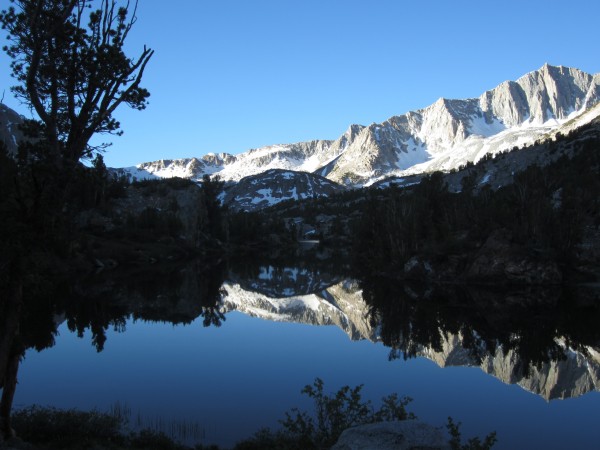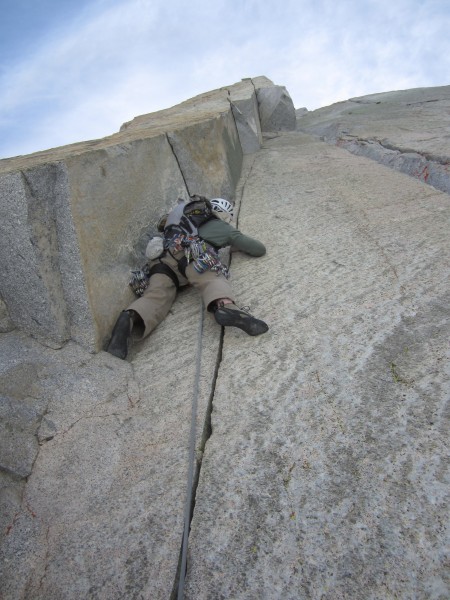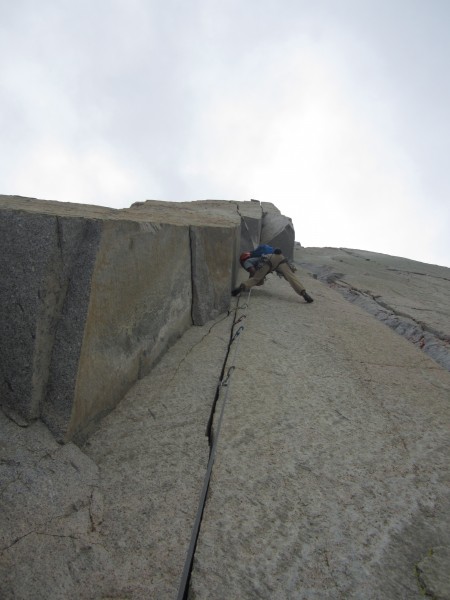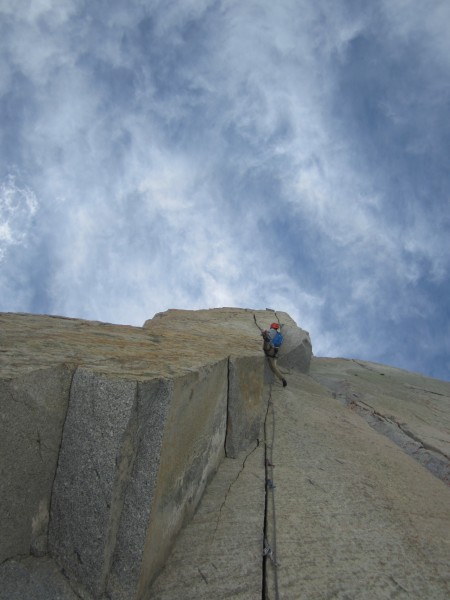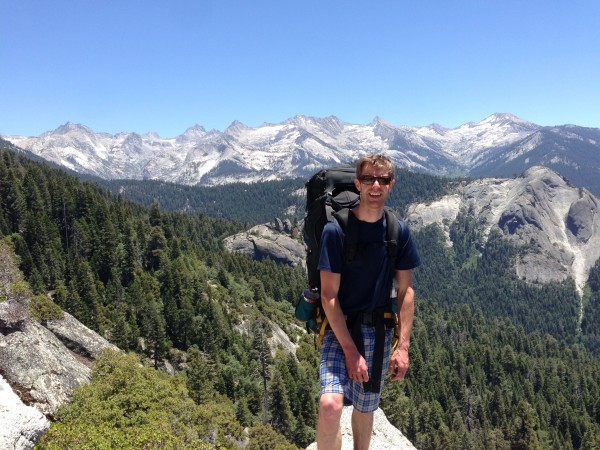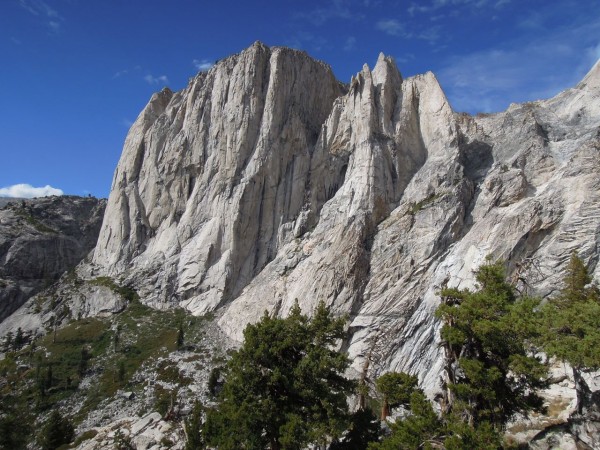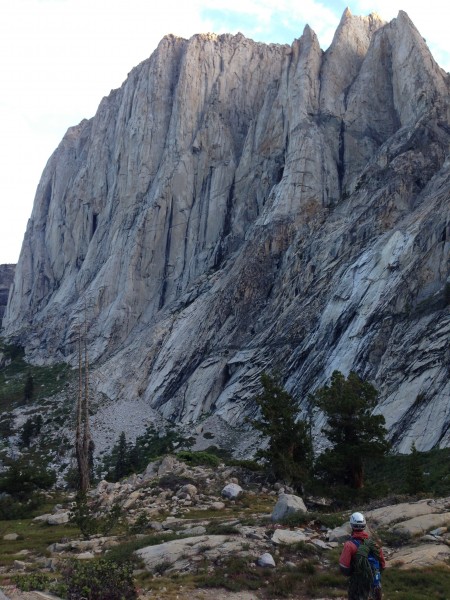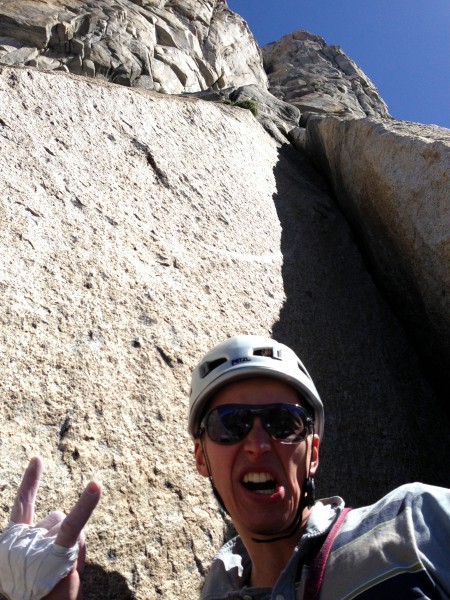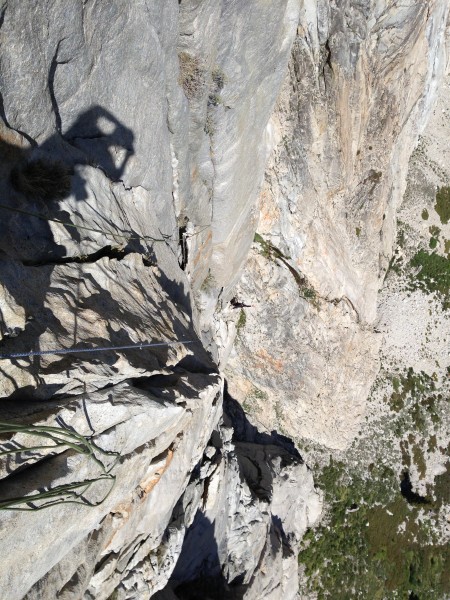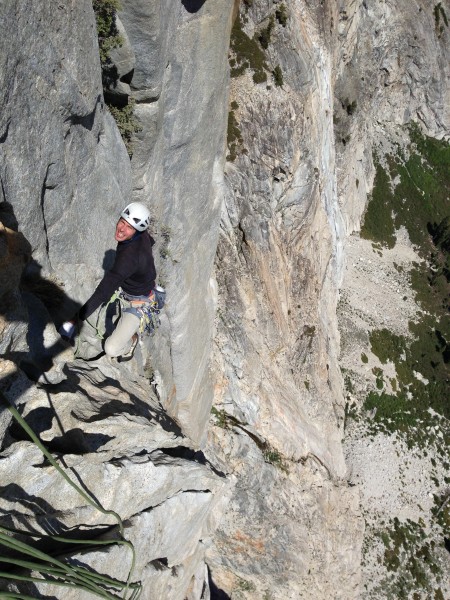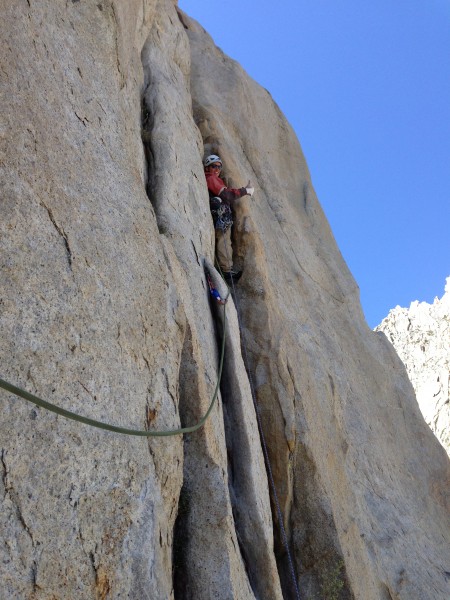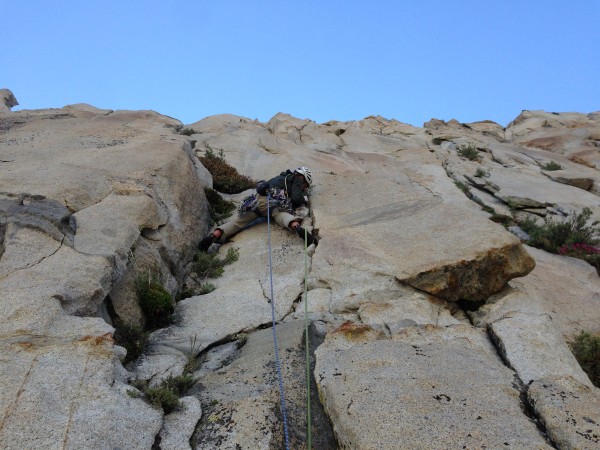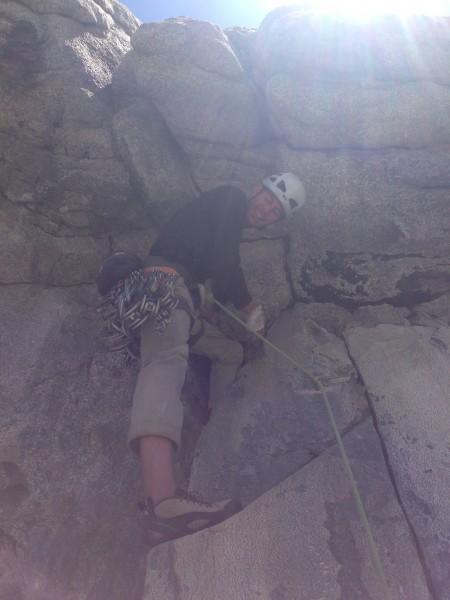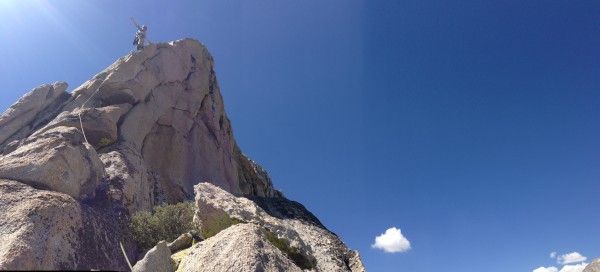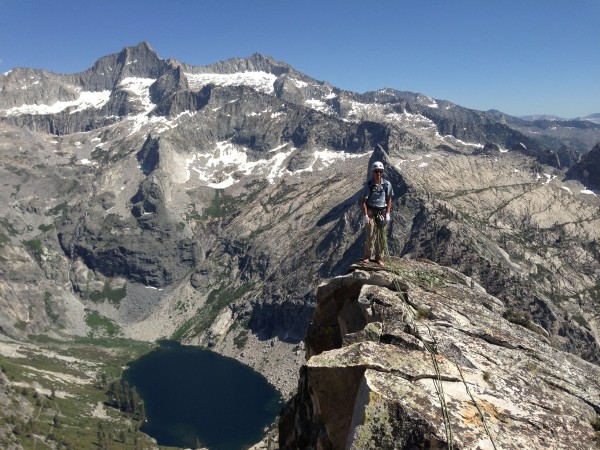As always, a fair bit of preparation goes into climbing routes like Valkyrie (1800’ route graded 5.12). As a means of last minute preparation I teamed up with my friend Dylan to climb a long route in the valley the weekend before. However, hot temps forced us to head to the high country and good chance of thunderstorms reduced our options north of Yosemite and we decided to try the new “deluxe” variation on the North Buttress of Mt. Goode. The Variation was put up last year by Peter Croft and Hayden Kennedy and was originally rated 5.11+ with only two pitches of hard climbing.
As we hiked out from the South lake trailhead, who should we run into if not Peter himself? I think he was psyched that we are going to try his route and tried to crack a joke: “So… do you have a topo?” Peter gave us some beta for where to traverse on the first 5.11 pitch and off we went.
Dylan and I simulclimbed the 2 easy pitches on the regular North Buttress that put us right below the steep headwall, which the reg. route traverses around. From there I took the lead and climbed straight up the discontinuous cracks of the headwall. The moves were never hard on the first pitch, but climbing was very mental with tricky gear and LOTs of loose flakes. Several times I lifted my foot to have whatever I was standing on fall out of the wall. I left several larger and obviously loose blocks for Dylan to “trundle with wild abandon”. The traverse at the end that Peter talked about was easy enough in several places and we didn’t end up following his beta. We thought this pitch came in at 11- and that it would take a while for it to completely clean up.
Dylan, being a self proclaimed “crack climber” decided to take the 11+ second pitch, which supposedly follows an amazing splitter through a small roof. He started up the awesome finger crack, but after 15 feet of climbing hung on a piece and declared that the crack is too thin for his “sausage fingers”. He then noticed a “sweet undercling” on the left wall that would “surely get him through the hard sequence”. He then grabbed the flake and immediately snaped a book-sized chunk off of it right above my head. I was happy that he held on to it!
He lowered and let me give it a try since my fingers are smaller. I got to the same spot where the cracks get way too thin for ANY human fingers and started laybacking the edge of this fissure. That lasted for about 2 moves before I was ready to spill my guts. I hung and proceeded to get all French on it. Walls on both sides are very smooth with only one or two awkward footholds for the whole way up to the roof. You have to layback the beast (crack is offset by no more than 1/4 of an inch) with your feet skating around on calcite and a bit of lichen. I couldn't even imagine firing in gear from the tips layback with no feet and still calling it 5.11+. This was solid 5.12 climbing. Sandbagged!
Not sure why Peter would give us beta on the “easy” 5.11 pitch and neglect to say that the second pitch is INSAINLY hard! After getting to the roof the difficulties ease and solid handjams take us to the top of the headwall. Simulclimbing the rest of the regular route to the summit feels awesome, but the crux pitch left a bit of a “bad taste” in my mouth.
On the way back to the car I start to have doubts if I can pull off the 5.12 climbing on Valkyrie if the 11+ is already shutting me down. I later found out from Townsend that his friend Jim was on Angel Wings trying to repeat Valkyrie and didn’t manage to free a traverse on pitch 9 (5.11) and it made me even more apprehensive. On the other hand, they reported that the supposed 5.12 pitch was not too bad.
The next few days were spent preparing for the 4 day trip and I found the tension dissipating. I was getting really psyched again! Townsend and I drove out to Sequoia on Thursday after work and started hiking early on Friday. Packing a full rack to 5”, rope, tag line, tent, and enough food for 3 nights and 2 climbing days meant that we could barely lift our packs. To say that the hike was brutal would be an understatement. First half of it went quite nicely with cool views of Castle Rocks and high mountains east of Valhalla.
After about 11 miles, when you pass the Bearpaw Meadow camp a sign reads “Hamilton Lakes 4 mi”. Don’t believe it. Not only it’s more like 6 miles, but it feels even longer than the 11 miles that you hike at first. Finally, we arrived in Valhalla. Passing under Angel Wings you realize two things: you have to walk for another 20 minutes (damn!) and Angel Wings is HUGE! I mean MASSIVE! The pictures that I’ve seen before don’t describe the scale of it at all.
The camp is beautiful, surrounded by rock on all sides with insane terrain features reminiscent of death slabs and domes above them. The critters near the Hamilton Lake are out of control. Within minutes of our arrival there were several deer in our camp and two marmots were trying to outflank me in attempt to get to our packs. I’ve never experienced this level of impertinence from wildlife and was left to defend our food supply with my jaw agape while Townsend was filtering water. I snuck in a quick dip in the Hamilton Lake before stuffing my stomach and passing out in the tent. Exhausted!
Waking up at 5 am, we quickly packed up and headed up to get in line for Valkyrie... NOT. Joking aside there were two other climbers out there, but we never saw them on the rock and it felt like we have the whole mountain to ourselves. I linked the first two pitches, while Townsend simuled to the first belay. Rope drag at the end of the 180’ 2nd pitch almost pulled me off the insecure 5.10 slab moves. It didn’t help that the granite chips were crunching off under my feet. This is going to be tough! Townsend took over the lead on the 3rd pitch and discovered a few quarter inchers that reminded us of the amount of time it took to finish off the FA of this route. This became the norm – new shiny bolts were mixed in with the old relics fitted with Leeper hangers. The “bushy cracks” were totally filled with vegetation and in a few spots we were yarding on the bushes with both hands. On the forth pitch glorious hand crack slowly becomes narrower until it almost disappears and you – pumped out of your mind – have to do a very tricky crack switch and another insecure and reachy bolder problem to get to the belay alcove. Another 5.10 pitch that I barely sketched through.
Since, I was struggling with the climbing, I was happy that Townsend got the 5th pitch (5.11), but we quickly realized that the climbing is fun and not bad at all. He linked it with the 6th.
Pitches fly by, until it’s my turn to lead the 9th, that our friends didn’t manage to free. By this time Townsend already dispatched two of the crux pitches, so I really have nothing to complain about. Time to sack up! The climbing is thin, sustained, and wandering from the beginning. I end up clipping all the bolts with long runners, skip one completely and back clean the draws on two more to reduce the rope drag. After the very thin crimpy stuff is over, you clip a bolt and make a long step to a barely-there little ramp, no bigger than half of an inch and sloping. Departing from the security of hand holds you try to claw at the granite grains in front of your face, but deep inside you know that only the friction of your shoes is holding you on the vertical wall. Relieved after grabbing a real hold at the end of this 5 foot traverse we were psyched to climb this pitch on our first try!
The next two pitches that we linked traversed more to the right putting us first on a huge detached pillar (“Chiclet towers”), than onto “Valkyrie’s perch” – a 2 by 2 foot block that seemed to be surrounded by air on 3 sides and overhung the base of the wall by at least 50 feet. Definitely one of the most exposed belay ledges ever!
I took over the lead again thorough another all time classic pumpy hand crack putting us at the base of the 13th pitch (5.12).
On the crux pitch Towsend clipped a high bolt, downclimbed, grabbed a single hold in the middle of the otherwise blank face and reached far right for a good flake in the neighboring crack system. “Not too bad!” This was our last hard pitch and the route seemed to fall together without much problem. Let me not get too far ahead of myself, though. I was pretty worried about the “5.10 squeeze” on p14. Jim warned us that it was the wyde crux on the route. The beginning was a straight-forward gruntfest and I almost started to relax.
However, during yet another crack switch, I thought that I got off route and downclimbed to traverse in another place. Looking up into the flared groove that I was supposed to traverse into I wanted to have nothing to do with it. I traversed back through the no-hands slab, groveled back up the squeeze chimney, and stared at the higher move getting into the groove. I needed to make this happen! Finally I found a tiny knob to stand on, swung my body over and found myself in very insecure flared jam territory with my feet sliding down the licheny groove. I still don’t know what I did there – I might have tried to double-Gaston the two sides of the groove, or stick to the insecure flared cupped-hand jams, or just willed my feet to get higher in the crack, but eventually I could reach a sloper and pulled myself up into easier territory. Whew! That was a close one.
Townsend got another “bushy crack” on pitch 15, which made me wonder if, with that luck, he digs “bush” in his non-climbing life as well.
50 feet up pitch 16 I realized that we are completely off route. We missed an arrow in the topo that suggested we climb around the arête and not wanting to traverse around the arête late and hose myself with ropedrag I downclimbed the 5.10 layback. After that effort, I was getting very tired and decided to relinquish the lead to Townsend, who was by now shivering at the belay and needed to warm up any way. Delicately balancing on the arête he placed our #5 where I couldn’t see it and surprisingly started face climbing up. No real crack, just a perfect #5 placement! Finally, succumbing to ropedrag after 170 feet Townsend brought me up and I finished the rest of the 200’ pitch and the short 5.6 to the summit. Even on our last pitch there was some very mental climbing with a 50 foot stretch of fairly real climbing protected by two C3s that could only fit half way into the cracks. Again, I was very happy to not fall at the top of the pitch, otherwise, as Townsend said, I “would have ended up right next to him”.
We were ecstatic to have completed this awesome route and after taking in the view at the summit ran down the talus towards our descent.
In retrospect, we should have probably spent a bit less time at the summit as darkness caught us right at the crux of the descent. We realized that we were in the wrong descent gulley right when the last light faded. Trying to scramble over a ridge into a gulley left of us we ended up rapping off a tree, then scrambling down to another tree, rappelling, than we discovered a single anchor bolt. We found ourselves less and less in a place that matched the descent description, but still had some hope that we were on route. We backed up the bolt and rappelled again, this time over an 80 foot vertical cliff. At this point we were in deep forest and could hear the Lone Pine Creek that we crossed on the approach. We totally effed up this time!
An hour of bushwhacking through thick brush and much discussion about our options brought us to a huge fallen tree. We decided to take a 15 min break and talk our situation over. Do we stay here and cuddle the rest of the night? Do we continue our bushwack and risk getting cliffed out? We decided to keep going and after a few minutes came to some open slabs. Running down them, we could see a path below that seemed very even. TRAIL! Now we knew that we overshot the descent by a long haul and lost lots of elevation. However, at last we were safe and an hour-long march up the trail brought us back to our camp around 11:30. I tried to crack a joke, that we should reset the alarm to 6 am, so we could get an extra hour of sleep before going climbing tomorrow, but it wasn’t well received. After stuffing our faces with turkey chili we passed out in the tent close to 1 am. BEYOND EXHAUSTED!
So, normally at this point the TR would be over. I’d say thanks for reading, it was fun… but not this time. I don’t really know what caused us to wake up before the alarm went off at 6 am. Was it the deer that were trying to break into our “deer box” or the Colorado climbers, who were getting ready for their own adventure? I think I’m going to blame the stench in our tent. At this point we were pretty dirty with dried up blood, sweat, and vegetation stuck to us all over the place. The dinner last night also didn’t help. Long story short, we managed to get out of the tent and get ourselves ready for another climb. Somehow, it didn’t feel like we were planning to have “type 1” fun, but it had to be done. We weren’t rushed, thinking that South Arete Direct is a bit shorter and easier. I also think that both of us were secretly hoping that the other will fold the cards and call it quits.
That didn’t happen. Instead we found ourselves taking the long gulley to a large ramp system on the approach. South Arete starts about level with the 5th pitch on Valkyrie and has a few pitches less on it. The approach was most definitely not 3rd class. Towards the end there was a mossy 5.7 section, where I had to chalk up and even attempted to put in a knee bar to get a rest. I offered Townsend a rope. We lounged around at the base for 15 minutes until Townsend brought up the awkward question “So who wants to lead the 1st pitch?” No takers. It’s only 5.10 in the topo, but the climbing didn’t look inspiring with grassy steep crack that lead into a 5.9 squeeze chimney. Finally, after another 10 awkward minutes passed by, I decided to step up to the plate. After all, if I climb first, then Townsend will get the scary “black roof” pitch.
First pitch definitely sets the mood for the first half of the route. It’s hard right off the deck and climbs even worse than it looks. Insecure steep crack offered barely enough protection in between vegetation and also took me forever as I had to puzzle out a few sequences. It made both of us worried as we were hoping to not get benighted again. However, the rest of the route went much quicker. We linked pitches 3 and 4 with some simulclimbing which brought us to a belay ledge just under the “black roof”. It looked hard and grovely. We spotted a killer knee bar at the lip of the roof, which worked great, but failed to execute the moves getting out of it. This move was harder than any single move on Valkyrie, but also unpleasant. We quickly moved over to another major chimney system and tried to get that over with as well.
At the end of pitch 7, you get out onto the arête proper, and the route completely changes its character. The rock turns golden orange, with many crazy features: jug-flakes, chicken heads, and even huecos. This second half of the route is another Dave Nettle addition to the area that makes climbing in the Sierra so much fun! We followed the blunt arête up another two stellar 5.10 pitches. The “double fisted cracks” pitch is one of the coolest pitches we ever climbed. It’s hard to describe – you kind of have to be there to understand. After that the climbing mellows out and 3 blocks of simulclimbing on the VERY EDGE of the arête brought us to the summit.
Surprisingly, the South Arete makes up the highest summit of Angel Wings. We were psyched to get this route done in only 6 hrs, even if we had to aid though 1 move and thought that we are going to redpoint the descent for sure this time. Low on energy, we were moving twice as slowly down the talus, that we ran down the day before. This time we identified the “spur with boulders” that we were supposed to take on the descent. However, instead of heading left like we should have, we took the broad gulley on the right. Again, we botched the descent, but at least it was easy to walk down the low angle slabs in daylight following scraps of vegetation. At the bottom, we got to another tree, from which we could see the trail. A short rappel and 5 minutes of intense bushwacking brought us to it.
We were a little disappointed in our lack of “descent finding” skills, but at least we had plenty of daylight to burn this time and dinner before sunset was guaranteed. My legs were so tired by this point that I couldn’t keep up with Townsend and got back to camp half an hour after him. I caught myself spacing out under Angel Wings, admiring its beauty and reminiscing about all the pitches that we climbed in the last two days. Another dip in the lake, angel hairs pasta (ha!), and we passed out in the tent around sunset. SEVERELY EXHAUSTED!
Finally, our last night in Valhalla, we managed to sleep in and get an awesome and much needed rest. Getting up was difficult, ALL the muscles were sore, joints swollen, hands felt like lobster claws. After getting up and making breakfast, all we could do for a while was sit around and occasionally exclaim: “Ho Man!” Not much more needed to be said.
By the time we finished breaking down our camp and packing up, we felt human. Again, the first half of the hike was pretty nice with enjoyable views, but by the middle you start wishing it was over. By the end, I was barely shuffling my feet. ÜBER EXHAUSTED!
I’d like to say thanks to Dave Nettle, Brandon Thau, Peter Croft, Greg Epperson, Jim Nowak and others who spent so much time and effort putting up these amazing routes so far from the road! Valkyrie is a true hardman route with 1800’ of climbing up to 5.11+ (11 pitches of 5.10 and 4 x 5.11), sustained, proud and beautiful. The approach adds a lot to the experience and makes it that much more memorable and worthy! South Arete Direct is a beautiful climb that is very doable for a capable 5.10+ leader with a single move of aid and is not to be overlooked as well (of course, if you are not exhausted by then it also goes all free).
Townsend and Dylan! Thanks for sacrificing your knees and doing these awesome adventures with me!
Vlad
